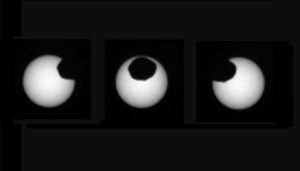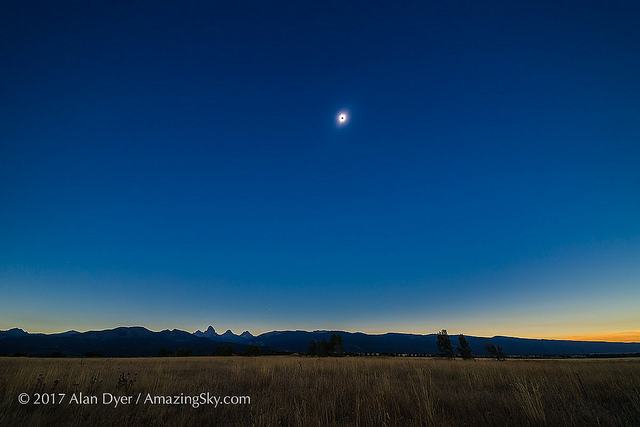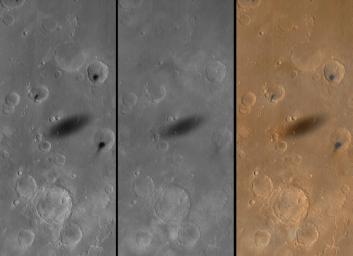NASA's Curiosity rover just spied transits of both Martian moons across the face of the Sun — including one that happened after the Sun had set.

NASA / JPL-Caltech / MSSS / Sequence: Dave Dickinson
In Andy Weir's book The Martian, stranded astronaut Mark Watney uses the rising and setting times of the Martian moons, Phobos and Deimos, as a rough form of "dead reckoning" to help him find his way. This past week, an astute observer combing through recent images from the Curiosity rover turned up an equally interesting sight: the shadow of the innermost moon Phobos as it slid silently across the face of the Sun — after the Sun had just set.
Only days before, Curiosity had also caught a transit of Deimos, and now NASA has released a set of images from both solar transits as seen from the rover's perspective, using solar filters attached to Curiosity's Mastcam.

NASA / JPL-Caltech / MSSS
"More observations over time help pin down the details of each orbit," says Mark Lemmon (Space Science Institute / Texas A&M University) in a recent press release. "Those orbits change all the time in response to the gravitational pull of Mars, Jupiter, or even each Martian moon pulling on the other."
Curiosity has spotted such transits before, but this is the first time it has seen the shadow of Phobos cross the sky after Martian sunset.
Chasing Moon Shadows on Mars
This unique phenomenon was first noticed and posted by user FredK on the Unmanned Spaceflight Forum on March 26th. The images, taken by Curiosity's right Navcam, seemed to show a shadow crossing the sky, probably cast through a thin layer of suspended dust in the tenuous Martian atmosphere.
This piqued the interest of Jet Propulsion Laboratory's Doug Ellison, who processed and stacked some of the images and then posted the thread on Twitter (he's @doug_ellison). NASA later released a formal sequence of the incredible sight:

NASA / JPL / Caltech
"We knew it was coming (we planned the observation to capture it after all)," says Ellison, "but it was amazing to see someone out there figure it out... it was pretty subtle in the raw public .jpgs!"
Now, Curiosity is no stranger to Phobos's irregular transits. (We refer to them as transits rather than eclipses, because the moon is on average 12 arcminutes across and never fully covers the 20.5-arcminute-diameter Sun, as seen from the Martian surface.) NASA engineers have even used observations of such events to pin down the precise orbits for the moon. Opportunity has snapped transits of tiny Deimos in the past as well.
What's unique this time is that the final sequence catches the event after local sunset. Ellison ran the circumstances for the rover for around 4:49 Universal Time (UT) on March 26th and confirmed the transit. Heck, the shadow even looks eerily like a redux of the Moon's shadow seen crossing the sky during a total solar eclipse on Earth.

Alan Dyer / Amazing Sky
Phobos and its shadow have turn up in other images, too: NASA's Mars Global Surveyor orbiter has seen the moon's misshapen shadow flitting across the Martian landscape.

NASA / JPL / MSSS
And Mars Insight has also recently documented a distinct darkening when Phobos transited the midday Sun as seen from the lander's location:

NASA / JPL-Caltech
Insight is even expected to detect small land tides raised by Phobos as it passes overhead.
Phobos orbits Mars once every 7 hours and 39 minutes from just 3,721 miles (5,989 kilometers) above the Martian surface — the closest any moon orbits its host planet in the solar system. Because it orbits faster than the planet rotates, a Mars-based observer will see Phobos rise in the west and set in the east — a truly bizarre sight.
The post-sunset transit is a testament to what keen-eyed observers can turn up in planetary imagery, with a little skill and patience. Perhaps one day human eyes will witness the subtle shadow of Phobos sliding overhead. Our best bet though, is to travel to the slopes of Elysium Mons, where on November 10, 2084, one could spy Phobos, Earth, and the Moon transit the Sun at the same time.
Of course, there's a slight bit of uncertainty in calculating such a far-off event; we promise to rerun the simulation come 2083. Let's see, by then I'll be . . .
 2
2









Comments
John
April 5, 2019 at 5:28 pm
Hmmm, 2084 - I'll be 140...I'll have to skip that one...
You must be logged in to post a comment.
misha17
April 8, 2019 at 10:27 pm
"We refer to them as transits rather than eclipses, because the moon is on average 12 arc minutes across and never fully covers the 20.5-arcminute-diameter Sun, as seen from the Martian surface."
An annular eclipse is basically a transit, since the moon doesn't cover the sun. How small a % must the obscuring body appear, before it's considered a true transit and not an eclipse? And is the "%" the diameter of the larger body that is covered (what is usually measured to describe the magnitude of an eclipse), or is it the area of the larger body that is covered?
You must be logged in to post a comment.
You must be logged in to post a comment.